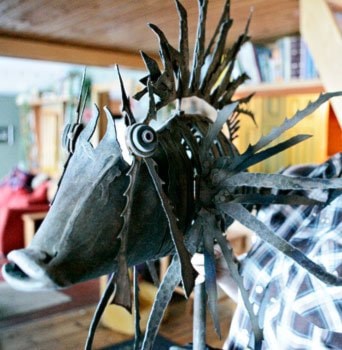Fresh out of craft school, strapped for cash, and in need of welding equipment, Yukon artist Katherine Alexander needed an idea, any idea, that could solve her financial woes and jump start her metalworking career.
She found inspiration in the cutlery drawer.
Taking a fork and bending it into a stylized insect, Alexander stumbled upon an instant kitsch classic.
A profitable instant kitsch classic, she soon realized.
After expertly mutilating every fork within reach, Alexander loaded up her truck and set forth on the West Coast summer craft fair circuit, determined to amass the money needed to buy the forge and materials that would eventually let her create the metalwork creations that dwelled within her imagination.
At fairs, Alexander would take an old-fashioned refrigerator, cover it in fork-bugs and top it with an abstract steel sculpture of a lion fish. By turning a crank on the side of the fridge, Alexander causes the sculpture to rotate.
The fridge-and-emaciated-fish set her apart from the typical craft fair monotony of blown glass, hemp bracelets and felt things.
There was also poetry in the simple action of going to local thrift stores, buying out a town’s supply of discarded forks, and then selling them back as art.
The selling process has become relatively routine.
“I just stand there and crank, and then people go, ‘Whoa, what is that weird thing over in the corner,’ and they come over, smile and say, ‘Wow, bugs made out of spoons!,’” she said.
“And I say, ‘No, bugs make out of forks!’ … and then they buy one,” explained Alexander.
“I’ve been living off this one-trick-pony display for five months,” she added. She estimates that she’s sold between 1,000 and 1,200 bugs.
The bugs are not art, they are merely conduits to art, says Alexander.
“If I didn’t have these, I wouldn’t be able to be making what I am right now,” she said.
Two years ago, Alexander abandoned a dreary career and enrolled in a welding course at Yukon College.
“I don’t really remember what I did in my (pre-welding) life; I’ve washed it away,” said Alexander.
“It’s probably all the heavy metals my body’s accumulating from inhaling all the fumes and the gases,” she added.
For no reason that she could grasp, welding had always intrigued her.
“No reason at all, I only had a deep desire to learn how to weld,” she said.
After a few opening lessons, Alexander described the students being placed into “cement cells.”
“You just sit there, staring at cement and then you just weld plate after plate after plate after plate,” she said.
“And you just do that for five months straight — you’re not making anything,” she said.
The creeping entropy of the experience did not phase Alexander. For her, the Zen-like simplicity of the activity was bewitching.
“I got blissed out from it, everyday I was so happy,” said Alexander.
“All you’re doing is being ‘one’ with your puddle; you’re just staring at this tiny little glob of melted metal and making sure you can make it as pretty as possible,” she said.
Surrounded by the next generation of gruff, solitary welders, it’s arguable whether or not Alexander’s spiritual overtures were shared.
“I think I was the only one in the class who saw it as a religious experience,” said Alexander.
Where others find solace in scented candles and rock gardens, Alexander finds her peace behind a mask and apron, bathing in the sparks and fumes of metalwork.
“Everyone else has discovered yoga, and I discovered welding,” said Alexander.
“All of my generation is busy drinking green tea, breathing deeply and doing poses and I’m melting things together,” she added.
The medium is mysterious.
Welding, especially, has a magical quality to it. When metal workers don the clothing of their craft, they become hooded fire-wielders commanding solid metal to assume new forms.
Metal is also delightfully two-faced. At once curvaceous and beautiful, metal can just as easily become a heavy instrument of death.
Pointing to the lion fish, Alexander noted that some people think the sculpture is “cute” because of its large lips — yet a forest of tetanus-laden saw blades line the fish’s back.
“Everything can be a little bit vicious and delicate at the same time,” she said.
Illustratively, for an upcoming show, Alexander plans an exhibition of metal lingerie.
Metal flowers, too.
Alexander hopes to one day build a steel garden outside one of the local garbage dumps.
Steel is Alexander’s metal of choice.
“It has infinite possibilities, you can make anything with it,” she said.
It’s cheap, and in more abundant supply.
For a month, Alexander worked at the Marsh Lake Dump purely to scrounge materials.
In homage to the trash origins of much of her material, Alexander’s business is called Nuisance Ground Designs, a “nuisance ground” being the former term for garbage dump.
“The term is much more elegant — and true,” she said.
Alexander’s metal creations will be on display at The Gritty Gallery, the new seasonal gallery at 505 Wood St. The grand opening is on Friday between 3 p.m. and 7 p.m.
Contact Tristin Hopper at
tristinh@yukon-news.com
